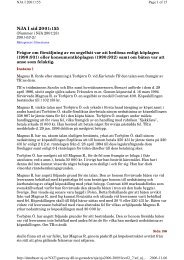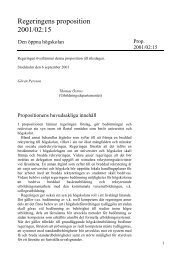A Study of the ITU-T G.729 Speech Coding Algorithm ...
A Study of the ITU-T G.729 Speech Coding Algorithm ...
A Study of the ITU-T G.729 Speech Coding Algorithm ...
You also want an ePaper? Increase the reach of your titles
YUMPU automatically turns print PDFs into web optimized ePapers that Google loves.
Open<br />
MASTER THESIS<br />
Datum - Date Rev Dokumentnr - Document no.<br />
04-09-28 PA1<br />
For each subframe <strong>the</strong> LSP-coefficients are interpolated and converted to LPC-filter coefficients.<br />
Then, for each subframe, <strong>the</strong> excitation signal is constructed by adding <strong>the</strong> adaptive<br />
and fixed-codebook vectors multiplied with <strong>the</strong>ir respective gain. The excitation is <strong>the</strong>n filtered<br />
through <strong>the</strong> LPC- (or short-term) filter. Finally <strong>the</strong> reconstructed speech is fur<strong>the</strong>r<br />
enhanced by a post-filter.<br />
The signal flow <strong>of</strong> <strong>the</strong> decoder is displayed in Figure 16 [16].<br />
3.6 <strong>G.729</strong>A<br />
Figure 15: Decoding principle <strong>of</strong> <strong>the</strong> <strong>G.729</strong><br />
The <strong>G.729</strong>A is a reduced complexity version <strong>of</strong> <strong>the</strong> <strong>G.729</strong>, i.e it requires much less processing<br />
power. The <strong>G.729</strong>A is bitstream compatible with <strong>the</strong> <strong>G.729</strong>. Thus, <strong>the</strong> speech can<br />
be encoded with an <strong>G.729</strong> encoder and decoded with a <strong>G.729</strong>A decoder, or vice versa.<br />
One important note though, <strong>the</strong> syn<strong>the</strong>sized speech <strong>of</strong> <strong>the</strong> <strong>G.729</strong>A is not as good as<br />
from <strong>the</strong> <strong>G.729</strong> in some cases. The <strong>G.729</strong>A has a MOS <strong>of</strong> 3.7, which is not toll-quality,<br />
compared to <strong>the</strong> <strong>G.729</strong> which has a toll MOS <strong>of</strong> 4.1. Therefore, one might question <strong>the</strong><br />
suitability <strong>of</strong> using <strong>the</strong> <strong>G.729</strong>A in a ToIP system which is intended to provide a high quality<br />
service. However, according to [1] <strong>the</strong> <strong>G.729</strong>A only suffers in performance during multiple<br />
tandem encoding (encoding and decoding <strong>the</strong> signal repeatedly) and is not a reason for<br />
anyone to not use <strong>the</strong> <strong>G.729</strong>A compared to <strong>the</strong> <strong>G.729</strong>.<br />
The <strong>G.729</strong>A has only some small differences compared to <strong>the</strong> <strong>G.729</strong>. The differences<br />
in <strong>the</strong> encoder and decoder are stated in <strong>the</strong> following two sections. The reader interested<br />
in detailed changes in <strong>the</strong> C source code should refer to document [17] and [31].<br />
3.6.1 Encoder Differences Between <strong>G.729</strong> and <strong>G.729</strong>A<br />
The modules which have been simplified are:<br />
• Perceptual weighting filter<br />
• LP to LSP transformation<br />
• Search for adaptive-codebook delay<br />
36 (78)





